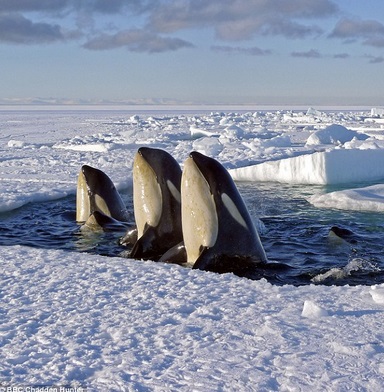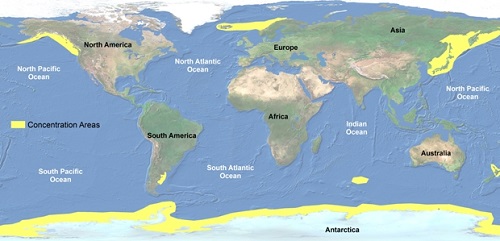0
Name

Photo from BBC Frozen Planet. There are not enough studies done on Orca whales for the IUCN classification.
- Scientific name: Orcinus orca
- Common name: Orca whale,
killer whale.
Taxonomy
- Kingdom: Animalia
- Phylum: Chordata
- Class: Mammalia
- Order: Cetacea
- Suborder: Odontoceti
- Family: Delphinidae
- Genus: Orcinus
- Species: Orcinus orca
0
Physical Features
- The orca whale is the largest member of the dolphin family.
- They have large black body with white belly and a grey saddle patch behind the dorsal fin.
- The lower jaw and the underside of the tail flukes are white.
- They have a distinctive white patch behind the eye.
- The dorsal fin is curved backwards in females while in males it is more triangular shaped. The dorsal fins of males are twice as large as those of females. They can measure up to 6.6 feet or 2 meters.
- Pectoral fins are large and serve them as paddles.
- They have strong teeth and jaws allowing them to shake their prey without losing them.
- Orca whales have a layer of insulation called blabber. The blabber is under their skin and ranges from 3 to 4 feet or 7.5 to 10 centimeters thick.
Habitat and Distribution
- Orca whales are the second most widely distributed mammal on earth after humans.
- They are seen in open waters and coastal areas in the Atlantic, Pacific, Arctic, Antarctic, Mediterranean and Indian Oceans and major seas.
- They do not have preference for water temperature.

Orca whales are found in all oceans of the world. This map shows the highest concentrations of the species. Photo source: Vancouver Aquarium
Weight and Length
- Males are larger than females.
- The average weight of males is 11,000 lbs or 5,000 kg and measure up to 30 feet or 9 meters in length.
- Females weight an average of 8,000 lbs or 3,600 kg and measure up to 25 feet or 7.6 meters.
- Calves weight 800 lbs or 360 kg and measure up to 9 feet or 2.7 meters.
Diet
- The killer whale is an apex predator of the sea, they are on top of the food chain and have no natural predators.
- Orca whales are top level carnivores and their diet depends on the season and region.
- They eat fish, squid, seals, seabirds, sea lions and marine mammals.
Behavior
- They are highly intelligent and adaptable. Their trainability has made them popular in shows at aquariums.
- They communicate by making clicks, whistles and pulse calls.
- Fast swimmers reach speeds of up to 33.5 mph or 54 km/hr.
- Not typically a migratory species but they will migrate in response to changes in food supply.
- Adults teach the young hunting skills.
- Studies in the North Pacific have shown that behavior among killer whales differ and can be divided into resident, transient and off-shore whales.
- They use echolocation to detect objects by emitting clicks and waiting for echoes.
- They are very social animals with complex societies and strong and stable social bonds.
Pods
- A group of whales is called a pod.
- Matrilineal groups contain on average 5 to 6 animals and all are related.
- Related matrilineal groups form a pod with up to 4 matrilineal groups.
- Clans are made up of pods with a common maternal heritage and share vocal patterns or dialects.
- DNA studies show that males mate with females from other pods.
- Pods have their own culture. Hunting techniques and vocalizations are passed through generations and are particular to that specific pod.
Reproduction
- Males reach reproductive maturity at 15 years old and females at 10 years old. Females reproduce until they are 40 years old.
- Females breed every 3 to 5 years.
- Gestation lasts from 15 to 18 months.
The Young
- Calves are born with a yellow-orange coloration which fades to white.
- The mother nurses its calf for up to 2 years. All members of the pod help raise the young.
Life Expectancy
- It is estimated that male killer whales live an average of 40 years in the wild, while females can live up to 90 years.
- In captivity they live an average of 25 years but some have lived into their 40s.
Threats
- Decline in prey.
- Increase in pollution.
- Targeted hunting.
- Incidental capture by commercial fisheries.
- The most common disease for wild orcas is jaw infection from tooth wear.
- In the Antarctica they depend on sea ice for foraging. Climate change makes these killer whales vulnerable to lower ice coverage and loss of habitat.
Conservation Status
- Small populations have been recognized as being threatened or at risk of extinction.
- Killer whales that inhabit the Pacific North West off the coast of British Columbia and Washington are on the U.S. Endangered species list.
More than one species?
- Scientists have been debating for years if all orcas should be classified as a single species.
- Studies in the North Pacific from California to Alaska show 3 different ecotypes of killer whales: residents, transients and off-shores. Ecotypes differ in physical features, behavior, social interaction and diet.
- Resident killer whales eat primarily fish and live in cohesive pods visiting the same areas consistently. Females have rounded dorsal fins that end in a sharp corner.
- Transient killer whales eat marine mammals. They travel in small groups of 2 to 6 and do not have strong family bonds. They have been seen traveling along the coast from Alaska to California. Females have triangular and pointed dorsal fins.
- Offshore killer whales travel far from the coastal shore and eat mainly school of fish. They gather in pods of 20 to 75 and are smaller than the other 3 types. Females have dorsal fins that are rounder.
- Other populations have not been studied.
- The IUCN has reported that the genus is in need of review and it is likely that Orcinus orca will be split in a number of species.
Fun Facts
- Orcas are dolphins.
- They have the second heaviest brain among marine mammals after sperm whales.
- Orcas are the most distributed marine mammal on earth.
- They consume up to 500 lbs of food daily, about 5% of their body weight.
- Orcas have a layer of fat called blubber underneath their skin which keeps them warm. It is about 3 to 4 inches or 7 to 10 centimeters thick.
- Orcas are called killer whales not because they kill humans but because they eat other smaller whales, dolphins and other marine mammals and are at the top of the food chain.
References and further research
Science News – Society for science and the public
Smithsonian National Museum of National History-North American Mammals
Australia Government – Department of the Environment- Orcinus orca
National Oceanic and Atmospheric Administration
